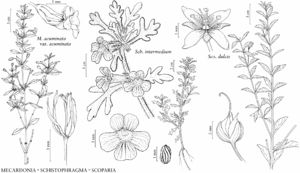Scoparia dulcis
Sp. Pl. 1: 116. 1753.
Annuals or perennials. Stems erect to ascending, usually much-branched distally, (17–) 30–100 (–150) cm, glabrous or puberulent. Leaves: blade oblanceolate to narrowly oblanceolate or rhombic, 8–53 × 3–25 mm, base tapered to cuneate, margins crenate to dentate in distal 1/2. Inflorescences: flowers 1 or 2 (or 3) per axil; bracts narrowly oblanceolate to narrowly elliptic, 4–35 mm. Pedicels 2–10 mm, glabrous. Flowers: calyx lobes 4, ovate to elliptic-ovate, 1.2–1.5 × 0.6–1 mm, margins ciliolate; corolla white, sometimes tinged pink or lavender, 2–2.5 × 3–4 mm. Capsules ovoid to subglobose, (1.6–) 2–2.5 (–4) × 1.4–2 mm. Seeds: 0.1–0.3 mm. 2n = 40 (India).
Phenology: Flowering May–Nov(–Jan).
Habitat: Marshes, wet hammocks, flatwoods, sandy woods, disturbed sites.
Elevation: 0–300 m.
Distribution
Ala., Fla., Ga., La., Miss., S.C., Tex., Mexico, West Indies, Central America, South America, in Asia, Africa, Indian Ocean Islands (Madagascar), Australia
Discussion
Scoparia dulcis is a pantropical weed. Noting that it was a widespread weed in lowland tropical America, F. W. Pennell (1935) believed that it was adventive in the United States. Most United States floras consider it to be native in the flora area, and it is treated that way here.
Selected References
None.
